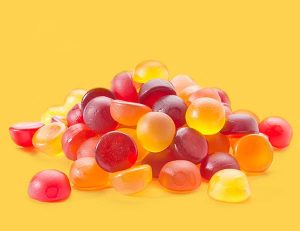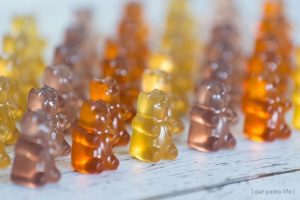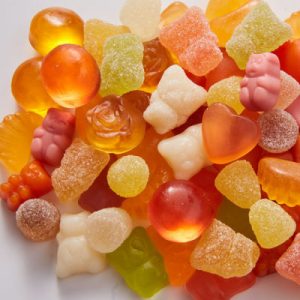Vitamin gummy sweets are among the most popular vitamin gummy types. These candies are so popular because, in addition to being quite tasty, they include all the vitamins and other nutrients that the human body needs to remain healthy.
Increasing demand has been observed for gummy vitamins, which are often shaped like fruits, vegetables, or cartoon characters. This is due to the current consumer preference for nutritional products and functional foods marketed as good sources of protein or other nutrients. Although nutritional food shakes are available on the market today, many still choose to consume their meals in gummy form rather than sipping or guzzling them. With the growing popularity of gummy vitamins, it is not surprising that Vitamin Gummies — one of the most popular varieties of gummies marketed on the market — have recently become a trending issue in the news media.
You may be curious as to how Vitamin Gummy Candy is produced at a factory. Consequently, you are not alone. In reality, the majority of individuals are interested in the procedure. Let’s examine the process from beginning to end. First, the vitamins are cooled to 65 degrees Fahrenheit and placed in molds. After the vitamins have cooled, they are taken from the molds and placed in big drum tumblers for drying.
Procedure for Making Gummy Candies
The production of gummy vitamins begins with the formation of a slurry. This liquid is then moved to a huge holding tank where pollutants are analyzed. The gelatin foundation and vitamin combination are then piped into a mixing tank, where they are combined and heated to 65 degrees Fahrenheit (18 degrees Celsius). The material is then put into molds before being let to cool. The candies are then placed on drying trays. The final process involves coating application and quality monitoring.
The gummy vitamin industry is extraordinarily lucrative. These sweets’ nutritional content and flavor have created a multibillion-dollar industry. Similarly, pharmaceutical gummy items are made. However, they contain active substances, whereas confections are produced simply for flavor. For this reason, the production procedure for gummy vitamins is comparable to that for candies. Consider the following considerations while launching a gummy vitamin manufacturing firm.
Ingredients
To create gummy vitamins, one must understand their manufacturing process. Traditionally, gummy vitamins are composed of sugar, citric acid, flavorings, glucose syrup, and gelatin. Some manufacturers substitute gelatin with agar-agar, dried seaweed, and pectin, which is a component of the cell walls of fruits. Vegan candy may also contain carrageenan, vegetable gum, and dextrose from tapioca.
In addition to gelatin, manufacturers of gummy vitamins must select the proper gelling ingredient, as this determines their appearance and flavor. Superior can take brands through the process and make gummies with clean labels and halal certification. CBD, CoQ10, and Omegas are additional compounds that may be added to vitamin gummies. Even manufacturers can add their substances, such as CBD, to improve the taste of the gummies.
Gelatin
Gelatin is a form of protein frequently employed in the production of gummy candies. Its key gelling property makes it perfect for a range of applications, from aiding in the swallowing of capsules to imparting marshmallows with a velvety, springy texture. Additionally, the protein is an aerating agent, emulsifier, stabilizer, film-forming, and water-binding substance. In addition to its gelling properties, gelatin has other properties that make it a highly useful ingredient in the production of vitamin gummy candies
Since the gelatin used in their creation does not include fat or cholesterol, gummy sweets are essentially odorless and tasteless. Gelatin is frequently sweetened with chemicals such as corn syrup, sucrose, and fructose because it has no inherent flavor. Sucrose, which is derived from sugar cane, has a high sweetness level, although fructose is somewhat sweeter. Another ingredient, maize syrup, keeps other sugars from crystallizing, provides body, and adds moisture.
Starch
The facility has a long history of producing vitamin gummy candy, but the underlying technology is still relatively new. Starch molding is one of the most recent technological advancements, and manufacturers of gummies containing useful substances such as vitamins, minerals, and natural extracts favor this technique. Using polycarbonate or silicone trays, a procedure replaces the traditional way of mold-making to manufacture these gummies. After the hot jelly substance has been put into the molds, an anti-sticking chemical is applied.
After stacking the trays in the molding station, they are transferred to a conveyor belt. The trays are then filtered with a sieve. The starch is then transferred to a recirculating conditioning system for starch. The starch is dried in the starch buck by the hot, flowing air. The starch is subsequently cooled by air jets and transferred to another portion of the Mogul.
Fruit powder
The production of gummy vitamins begins with an evaluation of the entering raw ingredients. In the quality control laboratory, these substances are evaluated for characteristics such as flavor, odor, and color. Additionally, the quality control laboratory examines the particle size of solids and oils and the pH of liquids. These tests establish whether or not the gummy vitamins contain a high concentration of phytonutrients. These results are used by the makers to produce their vitamin gummy candy.
In addition to gelatin, additional substances are utilized to create vitamin gummies. While gelatin is often linked with these items, there are plant-based alternatives that fulfill the needs of the expanding vegan and vegetarian population. Combinations of hydrocolloids can solve existing problems and create new opportunities in the creation of gummy candies. The usage of agar-agar to increase the melting point of vitamin gummy candies is one such instance. This will enable its resistance to tropical temperatures.
Vitamin mix
To produce vitamin gummy candies, the ingredients are combined. Then, food-grade oil and wax are added to preserve the suppleness of the gummy. The gelatinous fluid is then placed into a drum to solidify, and excess sugar is removed. The gummies are then placed in bottles and sealed by machines. After these stages have been completed, the gummies are distributed to retailers and distributors.
As raw ingredients for vitamin gummies, vitamins derived from biological sources are employed. The most common forms of vitamins are C and B. The nutrients are taken from plants and animals and then combined with gelatin powder. After the gelatin has been boiled, other ingredients are added. Calcium carbonate is used by certain producers as an ingredient, however, because it is insoluble in water, it does not dissolve in gelatin.
Water
The production of vitamin gummy candies in a facility using water begins with the evaluation of incoming raw materials. The evaluation of many properties, such as the particle size of solids, the pH value of liquids, and the odor of substances. These are then compared to the company’s specifications to guarantee that the ingredients yield candies of high quality. The next step in the manufacturing procedure is the addition of citric acid to create a gel-like consistency.
Gelatin is utilized to give gummy vitamins their consistency, which is crucial to their texture and therapeutic characteristics. Other components, such as gelatin, are incapable of delivering these distinctive qualities. As a result, many firms struggle with the amount of these chemicals in gummies. Therefore, vitamins are sprayed outside of the candy-like coating. Other producers can adjust the gelatin level of their gummies by adding sugar to the exterior of the candy.
Sweeteners
Vitamin Gummy Candy contains two varieties of sweeteners. The first ingredient is acesulfame-K. It is pH- and temperature-resistant and does not react with other components. The second artificial sweetener is aspartame, which is not as sweet but has a delayed sweetness onset and conveys flavor well. The combination of these two sweeteners produces a more balanced sweetness and flavor. Sucrose is the third sweetening agent.
In foods and beverages, artificial sweeteners have a long history of safety and are widely used. However, certain individuals may have adverse reactions to aspartame, the most prevalent artificial sweetener. Individuals with uncommon genetic disorders should avoid consuming aspartame products. There are other low-calorie sweeteners obtained from natural sources. These are typically created with natural components such as the sugar alternative Stevia. These sugar alternatives are chemically prepared, but they do not affect the end product.
Preserving Gummy Sweets
The production of gummy candies begins with the evaluation of raw ingredients. In the quality control laboratory, the ingredients are evaluated for their color, texture, flavor, and aroma. The starch is then filtered and evaluated for quality. The trays next pass through the mogul and into the mold impression and filling areas. The liquid mixture is then poured into the imprints.
Gelatin is used as a gelling agent in the manufacturing of gummy candies. It is derived from natural sources like fruit. However, vegan gelatin does not need to be bloomed. Both forms of gelatin produce thermoreversible protein gels with a firm, chewy consistency. The most common flavors of gummy candies are pineapple, orange, strawberry, and lemon. Manufacturers also add corn syrup or sorbitol to the candy to maintain its soft, chewy texture.
Packaging
Vitamin gummy packaging can be challenging for consumer-packaged goods manufacturers. There are several difficulties linked with gummy vitamin filling, including their stickiness and tendency to clump. Due to the aforementioned variables, linear scales may also encounter difficulties with gummy vitamins. Ohlson Packaging suggests a multi-head scale for this operation. Additionally, it is convenient. Additionally, adding more tastes helps enhance brand awareness. Consequently, it is necessary to select an appropriate packing option.
In 2019, the bottles & jars segment led the global market for gummy vitamins. This segment has airtight properties that shield the gummy component from outside elements. The bottles and jars are produced from either plastic or glass. These containers are transportable. The packaging of gummy vitamins in plastic jars and bottles is economical and practical. Additionally, gummy vitamin bottles are available in cartons. However, these containers are cumbersome and may not be suitable for vitamin gummy fillings.
Storage Life
The shelf life of gummy vitamins depends on various factors, including their shape and packaging. Some vitamins lose their effectiveness more rapidly than others, but they do not expire. A gummy vitamin with a flip-top lid, for instance, may not be as fresh as one with a screw-on closure. This could result in a vitamin expiring prematurely. A gummy vitamin packaged in an opaque container may have a longer shelf life than one packaged in a flip-top container.
The safety of the nutrients contained in these products is a major concern related to gummy vitamins. Some vitamin gummies may contain excessive quantities of particular nutrients, which can be hazardous to users’ health. This is a significant obstacle for the global gummy vitamin market. The solution is to manufacture vitamin gummies with natural fruit flavors. Thus, consumers may be confident that the product they are consuming is safe and free of any dangerous ingredients.
 Commercial Gummy Formulation Support
Commercial Gummy Formulation Support








